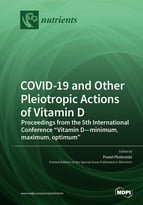COVID-19 and Other Pleiotropic Actions of Vitamin D: Proceedings from the 5th International Conference “Vitamin D—minimum, maximum, optimum”
A special issue of Nutrients (ISSN 2072-6643).
Deadline for manuscript submissions: closed (1 June 2022) | Viewed by 79940
Special Issue Editor
Interests: vitamin D and its pleiotropic action; guidelines of vitamin D supplementation; disturbances of calcium-phosphate metabolism; disturbances of bone tissue metabolism; body composition and biological development; basics of statistics; GLP; research methodology
Special Issues, Collections and Topics in MDPI journals
Special Issue Information
Dear Colleagues,
It is a great pleasure and a special privilege to welcome you to this Special Issue of Nutrients related to the 5th International Conference “Vitamin D—Minimum, Maximum, Optimum”, under the auspices of the European Vitamin D Association (EVIDAS).
The conference and the forthcoming papers serve as an international forum for the presentation and discussion of current basic and clinical research in the field of vitamin D. Organizing this subsequent Special Issue of Nutrients on vitamin D is a real challenge, given that the vitamin has recently been shown by prestigious medical journals as an epiphenomenon that coincides with diseases and that the correction of vitamin D deficits has limited clinical meaning. On the other hand, it is recognized that vitamin D deficiency is a global health problem with potential negative consequences on health, welfare, and morbidity during growth and adulthood, therefore influencing health care services worldwide. Thus, due to mutually exclusive conclusions, it is essential to discuss vividly, and share scientific reports and evidence demonstrating both the benefits and lack thereof in relation to human health. COVID-19 emerged over the last and current year; therefore, COVID-19 and vitamin D are the major issues that will be presented and discussed in this Special Issue.
Dr. Pawel Pludowski
Guest Editor
Manuscript Submission Information
Manuscripts should be submitted online at www.mdpi.com by registering and logging in to this website. Once you are registered, click here to go to the submission form. Manuscripts can be submitted until the deadline. All submissions that pass pre-check are peer-reviewed. Accepted papers will be published continuously in the journal (as soon as accepted) and will be listed together on the special issue website. Research articles, review articles as well as short communications are invited. For planned papers, a title and short abstract (about 100 words) can be sent to the Editorial Office for announcement on this website.
Submitted manuscripts should not have been published previously, nor be under consideration for publication elsewhere (except conference proceedings papers). All manuscripts are thoroughly refereed through a single-blind peer-review process. A guide for authors and other relevant information for submission of manuscripts is available on the Instructions for Authors page. Nutrients is an international peer-reviewed open access semimonthly journal published by MDPI.
Please visit the Instructions for Authors page before submitting a manuscript. The Article Processing Charge (APC) for publication in this open access journal is 2900 CHF (Swiss Francs). Submitted papers should be well formatted and use good English. Authors may use MDPI's English editing service prior to publication or during author revisions.
Keywords
- cholecalciferol
- calcifediol
- pleiotropic action of vitamin D
- COVID-19







